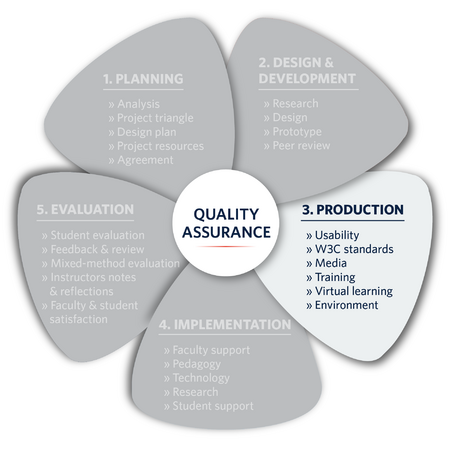Quality assurance designing quality online course production
Phase Three: Production (click to expand)
Phase three of the project is when production takes place, which means that the content/course will be developed online. At this stage, the final course content will be handed over to the Project Manager/Instructional Designer and s/he will work with the production team to prepare the course for the online learning environment. The course author will be asked to review content once it is uploaded online.
3. PRODUCTION
- • Follow W3C standards
- • Discuss / explore virtual learning environments (VLE)
- • Ensure tools and media support the course learning objectives, and learner interaction
- • Discuss usability
- • Ensure course design facilitates readability
- • Involve students to develop learner support resources
- • Train staff, learners, and instructors in selected VLE and tools
- • Create a prototype
- • Ensure course design accommodates the use of assistive technologies
Tasks to be completed by the Project Manager/Instructional Designer (click to expand)
1. The Project Manager/Instructional Designer will collect all the course content from the course author. S/he will work with the production team to design the layout of the course and ensure that all of the content is uploaded into an online course shell as planned.
2. While the course is in production, the course author/instructor will continue to consult on final versions of course materials. The course author will also have a chance to review the full course when everything is complete and produced for the learning environment. All the items listed in the image above need to be emphasized and focused on.
3. The production team follows the W3C standards to ensure that all the online components of the course are accessible. The accessibility checklist is available at http://wiki.ubc.ca/AccessibilityChecklist.
4. Instructional designer works with the production team and the instructor to ensure that selected media and tools support the course learning outcomes and learners interaction. It is important that all three interactions are present in an online course, learner with learner, learner with instructor and learner with content interactions.
5. Prior to the course start, it is recommended that online instructors have access to training sessions or an online orientation for teaching online. These sessions will help the course instructor to teach the course more efficiently and smoothly by offering online teaching tips as well as information on various online course tools. It is essential for instructors and learners to get familiar and comfortable with the platform that the course will be delivered in (whether it is Moodle, Desire2Learn or Blackboard Learn or any other learning/content management system). The Project Manager/Instructional Designer can help the instructor select a workshop best suited to their needs. For those who cannot attend face-to-face training, an online orientation/training session would be very helpful. In most of the organizations, there are ongoing training sessions. For example, at the University of British Columbia, the upcoming Connect training sessions and other workshops offered through the Centre for Teaching, Learning and Technology[1]
6. Discuss as a team and use a model such as ACTIONS for selecting e-technology.
ACTIONS Model (click to expand)
A
- Refers to Access. When selecting a technology, ask the following questions: How accessible is a particular technology for learners? how flexible is it for a particular target students?
C
- Stands for Costs in ACTIONS. What is the cost for each student? What is the cost structure of each technology? What is the cost of implementation and training?
T
- Refers to Teaching/Learning. These are the questions that you might want to consider when selecting a new technology. What kinds of trainings/learning are needed? what instructional approaches will best meet these needs? what are the best technologies for supporting teaching and learning using this environment? What skills does the technology develop? Can the subject/content be adapted to the technology?
I
- Refers to Interactivity: What kind of interaction does this technology enable? Synchronous or asynchronous? Is it user friendly? Easy to use and learn?
O
- Refers to Organizational issues in ACTIONS. Is it well planned and consulted within the organization? What are the organizational requirements to provide stability and support? What are the challenges/barriers/risk to using this technology successfully within the institution? How can we overcome those barriers? Have other organizations used the same technology for the same purpose? Lessons learned?
N
- Stands for Novelty in ACTIONS. How new is the technology? What are its capabilities?
S
- Refers to Speed in ACTIONS. How quickly can programs and courses be created with this technology? How quickly courses can be migrated to this technology? How quickly can materials be modified?
Supporting Quality Assurance Documentation (click to expand)
These are online resources created by the University of British Columbia for online learners and instructors. These resources provide learners and instructors with tips and information on how to use the tools and features in the current platform that the university is using to offer its online courses.
References (click to expand)
- ↑ Centre for Teaching Learning and Technology, University of British Columbia. List of events available at: http://www.events.ctlt.ubc.ca/
2. Bates, T. (2011). Models for selecting and using technology: 1. The challenge. Online Learning and Distance Education Resources. Available at: http://www.tonybates.ca/2011/06/13/models-for-selecting-and-using-technology-1-the-challenge/
License
|
|
